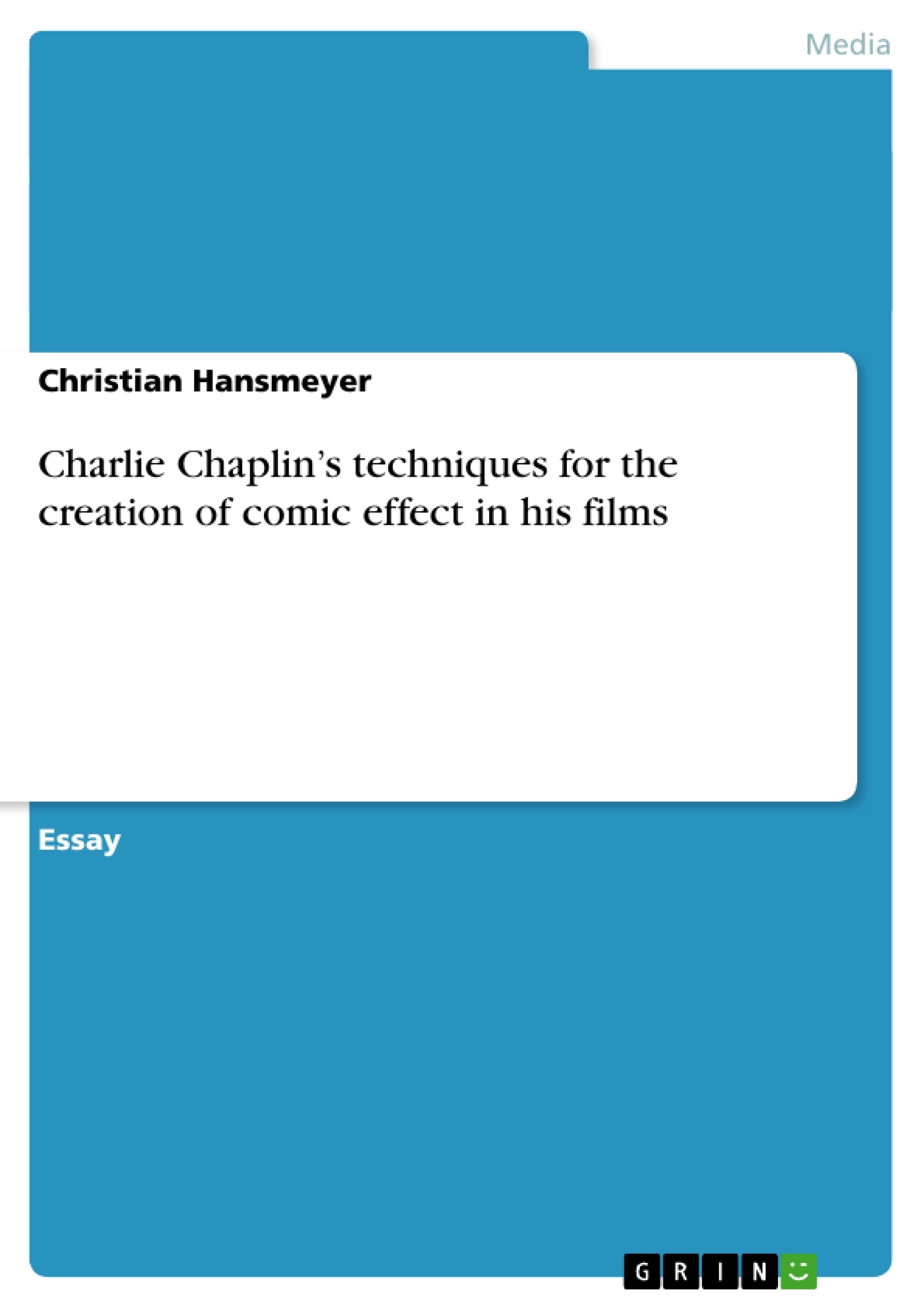Even more than a half century after his last appearance in the film Limelight (1952) and decades after his death in 1977, Charles Spencer Chaplin is one of the most famous characters and well-known actors of all times and is regarded as the greatest creative figure in the movies. Chaplin′s capacity for comic invention and his high quality of film output are outstanding among the film producers of his time. His comedies and satires, most of them directed by Chaplin himself, used to amuse people all around the world and still make us laugh today.
Apart from acting, directing and composing the music for his own films by himself, Chaplin developed his own techniques for the creation of comic effects, which can always be identified as his own style and is distinguished from those of other comedians of the twenties, for example Lloyd, Keaton or Langdon.
This essay will focus on these techniques and their development during the career of Charlie Chaplin.
Table of Contents
- Introduction
- The Creation of The Tramp
- Chaplin's Comic Effect Techniques
- Development in Techniques
- Conclusion
Objectives and Key Themes
This essay aims to analyze Charlie Chaplin's techniques for creating comedic effect in his films, examining how these techniques evolved throughout his career. The analysis will focus on specific techniques and their integration with pathos to generate both laughter and emotional resonance.
- The creation and evolution of the Tramp character.
- Chaplin's unique blend of comedy and pathos.
- The use of physical comedy and visual gags.
- The incorporation of social commentary into his comedic works.
- The development of Chaplin's comedic techniques over time.
Chapter Summaries
Introduction: This introductory section establishes Charlie Chaplin's enduring legacy as a comedic genius and a significant figure in film history. It highlights his multifaceted contributions as an actor, director, and composer, emphasizing the unique and identifiable nature of his comedic style, differentiating it from contemporaries like Lloyd, Keaton, and Langdon. The essay's focus is clearly defined: an examination of Chaplin's comedic techniques and their evolution throughout his career.
The Creation of The Tramp: This chapter details the genesis of Chaplin's iconic Tramp character, born in 1914 at Keystone Studios. It explores the comedic impact of the Tramp's attire—a deliberately contradictory ensemble of ill-fitting clothing—and his distinctive physicality, including his waddling gait and expressive body language. The chapter further develops the Tramp's personality, portraying him as a poor, unlucky, yet ultimately optimistic and resilient figure, constantly navigating social conflicts and embodying the struggles of the common man. The chapter highlights the character's inherent contradictions: a gentleman tramp, capable of both ungentlemanly behavior and surprising acts of gallantry, evoking sympathy and laughter simultaneously. Chaplin's own childhood experiences are presented as contributing to the Tramp's authenticity and relatability.
Chaplin's Comic Effect Techniques: This section distinguishes Chaplin's comedies from those of other comedians, emphasizing his unique approach of blending comedy and tragedy, creating humor within the context of pitiable circumstances. The analysis moves beyond simply identifying comedic elements to explore how Chaplin masterfully manipulates audience emotions, prompting both laughter and empathy. This section lays the groundwork for a deeper understanding of Chaplin's artistic approach, setting the stage for the examination of his techniques' development in the subsequent chapter.
Keywords
Charlie Chaplin, comedic techniques, The Tramp, physical comedy, pathos, social commentary, film history, visual gags, comedy, tragedy, film analysis.
Charlie Chaplin's Comedic Techniques: A Comprehensive Analysis - FAQ
What is the main focus of this essay?
The essay analyzes Charlie Chaplin's techniques for creating comedic effect in his films, examining how these techniques evolved throughout his career. It focuses on how Chaplin blended comedy and pathos to generate both laughter and emotional resonance.
What are the key themes explored in the essay?
Key themes include the creation and evolution of the Tramp character, Chaplin's unique blend of comedy and pathos, the use of physical comedy and visual gags, the incorporation of social commentary, and the development of Chaplin's comedic techniques over time.
What aspects of the Tramp character are discussed?
The essay details the genesis of the Tramp character, his attire, physicality (waddling gait, expressive body language), personality (poor, unlucky, yet optimistic and resilient), and the contradictions within the character (gentleman tramp, capable of both ungentlemanly behavior and gallantry).
How does Chaplin's comedy differ from other comedians?
The essay emphasizes Chaplin's unique approach of blending comedy and tragedy, creating humor within pitiable circumstances. It highlights his masterful manipulation of audience emotions, eliciting both laughter and empathy, setting him apart from contemporaries like Lloyd, Keaton, and Langdon.
What is the structure of the essay?
The essay includes an introduction, chapters on the creation of the Tramp, Chaplin's comedic techniques, the development of those techniques, and a conclusion. It also provides a table of contents, objectives and key themes, chapter summaries, and keywords.
What is covered in the introduction?
The introduction establishes Chaplin's lasting legacy, highlighting his multifaceted contributions as an actor, director, and composer, and emphasizes the unique and identifiable nature of his comedic style.
What is covered in the chapter on "The Creation of The Tramp"?
This chapter explores the origin of the Tramp character in 1914 at Keystone Studios, analyzing the comedic impact of his attire and physicality. It also examines the Tramp's personality and how Chaplin's own childhood experiences contributed to the character's authenticity and relatability.
What is covered in the chapter on "Chaplin's Comic Effect Techniques"?
This section differentiates Chaplin's comedies from others, focusing on his blending of comedy and tragedy and how he manipulated audience emotions to evoke both laughter and empathy. It lays the groundwork for understanding the development of his techniques.
What keywords are associated with the essay?
Keywords include Charlie Chaplin, comedic techniques, The Tramp, physical comedy, pathos, social commentary, film history, visual gags, comedy, tragedy, and film analysis.
- Quote paper
- Christian Hansmeyer (Author), 1999, Charlie Chaplin’s techniques for the creation of comic effect in his films, Munich, GRIN Verlag, https://www.grin.com/document/9087




